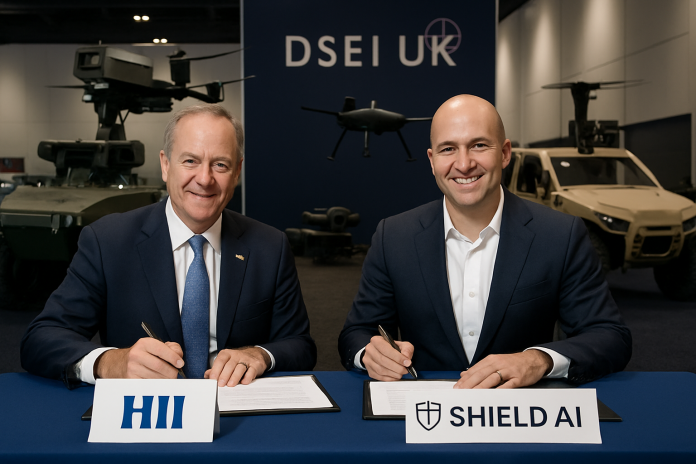Quick Take
- HII and Shield AI partner to integrate autonomous systems across air and sea domains
- Collaboration combines Shield AI’s Hivemind software with HII’s Odyssey platform
- Partnership targets Navy and allied forces with faster deployment capabilities
- Technology proven in Ukraine operations and unmanned vessel deployments
- Expansion addresses growing demand for coordinated multi-domain military operations
HII partners with Shield AI to deliver integrated autonomous robotics systems spanning air and sea domains
— Partnership announced at DSEI UK trade show combines proven technologies for multi-domain warfare capabilities
Huntington Ingalls Industries, the leading shipbuilder and maritime robotics company, announced a strategic partnership with Shield AI to deliver integrated autonomous robotics systems spanning air and sea domains. The collaboration, revealed at the DSEI UK trade show in London, brings together Shield AI’s proven Hivemind mission autonomy software with HII’s Odyssey suite to create multi-domain warfare capabilities.
The partnership focuses on integrating Shield AI’s Hivemind software, which has shown effectiveness in complex missions including operations in Ukraine, with HII’s Odyssey platform that powers unmanned underwater and surface vessels. This integration supports HII’s new Romulus family of vessels showcased at DSEI, featuring modular design for rapid deployment across military domains.
Technology Integration Spans Air and Maritime Operations
“We’re expanding our established air domain expertise into maritime operations,” said Nathan Michael, Shield AI’s Chief Technology Officer, highlighting the company’s strategic shift toward multi-domain warfare capabilities.
The cross-domain approach could fundamentally change military operational dynamics, according to Eric Chewning, Executive Vice President of Maritime Systems at HII. By combining complementary technological capabilities, both companies aim to enhance robotic systems for Navy and allied forces, addressing critical needs for operational speed and battlefield resilience.
Proven Platforms Drive Military Modernization
The track record of these technologies across various platforms, including unmanned surface vessels and aerial drones like the V-Bat, demonstrates their potential for collaborative military environments requiring seamless air-sea coordination.
This partnership positions both companies at the forefront of the autonomous defense systems market, which industry analysts project for significant growth. The collaboration strengthens HII’s maritime dominance while expanding Shield AI’s operational reach beyond traditional aerial platforms.
Regulatory and Ethical Considerations Shape Implementation
However, the strategic expansion introduces regulatory complexity, particularly regarding safe integration of sophisticated autonomous systems and ethical considerations surrounding lethal autonomous weapons deployment in military operations.
The modular integration approach enables military forces to deploy unified command and control systems across previously separate operational domains. This technological convergence supports faster decision-making cycles and improved mission effectiveness in contested environments.
Industry Shift Toward Integrated Defense Solutions
The partnership reflects broader defense industry trends toward integrated autonomous systems, as military customers increasingly demand platforms capable of coordinated multi-domain operations rather than isolated single-domain solutions.
Strategic Implications for Defense Leaders
Business leaders in the defense sector should evaluate integration opportunities to assess where cross-domain autonomy can streamline operations. Organizations must monitor regulatory developments affecting autonomous military technologies while investing in training and systems compatibility to ensure teams can operate new technologies seamlessly.
Leaders should prioritize security and ethics, maintaining focus on safe, ethical deployment of autonomous systems. The partnership demonstrates the value of exploring strategic alliances that leverage combined strengths of air and maritime technologies in an increasingly integrated defense landscape.






